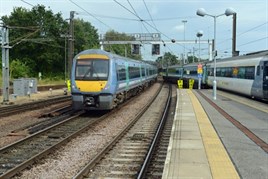Current Public Performance Measure (PPM) for the AGA franchise is 90.6%, according to figures dated to March 31 2015. This is below a peak of more than 92.5% two years ago.
The IC trains currently deliver 83.7% PPM. According to the prospectus, areas that are cause for concern include infrastructure failures (particularly track faults arising from issues with the renewals programme that is under way), increases in the number of fatalities on the route, increases in delays per incident and the ability of the service to recover after incidents, and the fact that early improvements made to fleet reliability in the AGA franchise have stalled.
The document states: “The introduction of other operators to the area will require good co-operation between all parties, particularly in times of disruption. A review of fleet management will be required, as these two additional operators will share maintenance facilities.
“There is much two-track railway with limited passing facilities, which has particular relevance in the context of an intensive service during peak hours.
“Although the reliability of the fleet is generally reasonable, the traction characteristics are basic and do not deliver modern acceleration or deceleration capability.”
The document goes on to draw attention to “anticipated committed infrastructure schemes that are directly linked to improving both speeds and performance”. These are listed as:
- Electrification of Barking-Gospel Oak will enable more efficient operation of the passenger railway, by avoiding the present arrangements whereby freight services emanating from North Thameside cross the Great Eastern Main Line at grade at Forest Gate to access the North London Line via Stratford.
A new 70mph crossover will be located from the main line to the electric lines west of Bow Junction, following the removal of Crossrail services into Liverpool Street high level station, thus allowing more efficient access to the higher numbered platforms at Liverpool Street.
- The single leads at Ely North Junction will be replaced by the ability to deliver multiple train moves simultaneously, thus removing the present constraint to increasing passenger services in the area.
- Line speed improvements on the Great Eastern Main Line are planned to permit 110mph operation. This will be achieved through renewals and removal of some level crossings, and through additional capacity provided from Coppermill Junction northwards towards Broxbourne.
Regarding ticketing, the prospectus states: “Rail Executive is likely to require bidders to put forward proposals for the improved retailing of products and services, from ticket search and acquisition to on-board and at-station services. Tickets should be easily accessible on the widest variety of media (smartphone, tablets, print-at-home), and their pricing, availability and time of use transparent in order to facilitate seamless travel across boundaries with other transport authorities.”
Whoever wins the EA franchise has tough conditions to meet - a demanding public and campaigners determined to see the transformation of a route that has traditionally been handed unwanted cast-offs from other regions. That transformation could be hard, but the rewards are certainly there if it is handled correctly.
- This feature was published in RAIL 770 on March 18 2015
















Login to comment
Comments
No comments have been made yet.